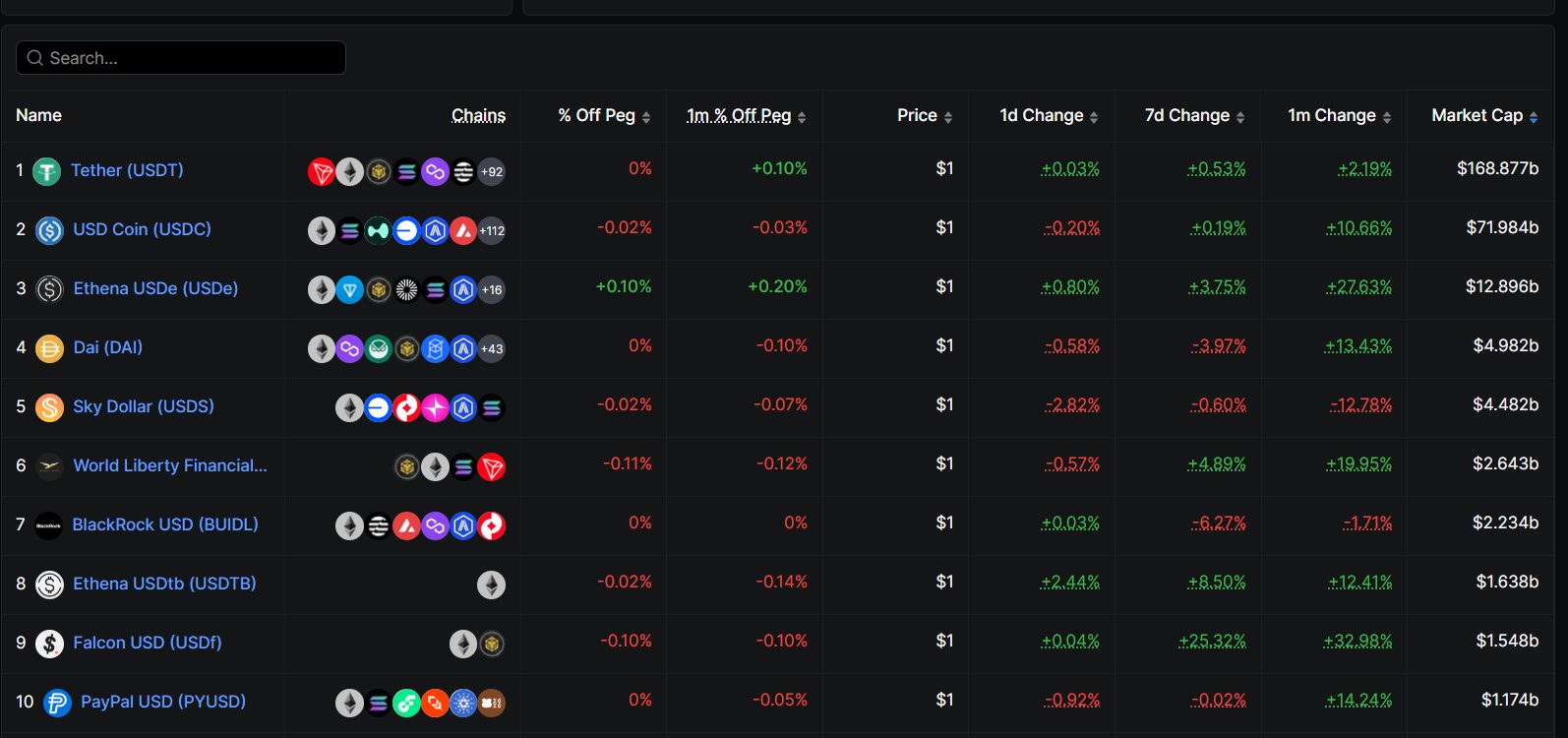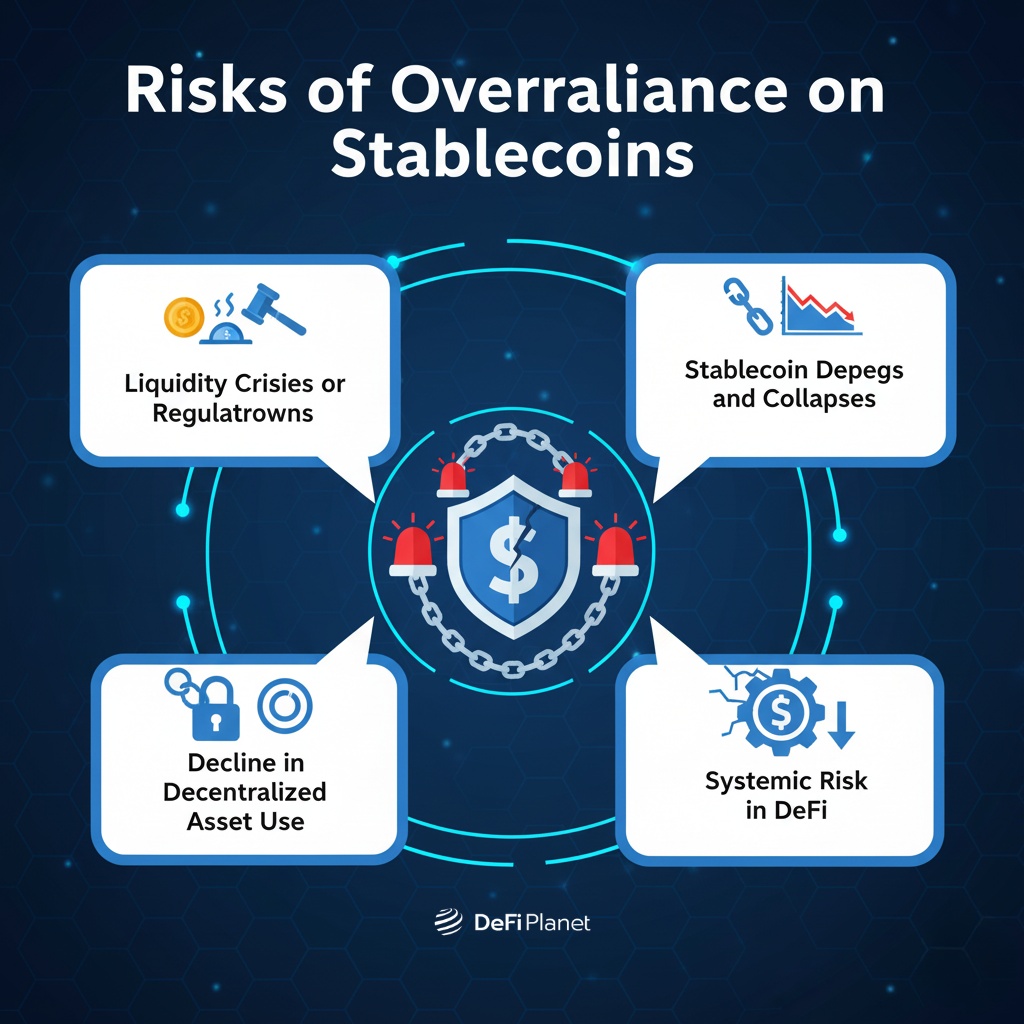Stablecoins have officially surpassed a $286 billion market capitalization, marking a major milestone in the evolution of the crypto ecosystem.
From Tether (USDT) and USD Coin (USDC) to newer entrants like PayPal USD (PYUSD), these fiat-pegged assets are playing an increasingly critical role across DeFi, centralized exchanges, and cross-border payments.
But this growing reliance on stablecoins raises a bigger question: Is it healthy for a decentralized ecosystem to depend so heavily on centralized, fiat-backed assets?
What’s Fueling the Stablecoin Boom?
Stablecoins have gained the confidence of both institutional investors and everyday users. This trust comes from their ability to hold a stable value while still being blockchain-native, which makes them attractive for everything from trading to holding value in uncertain times.
The fact that Tether (USDT) alone holds over $156 billion in market cap is a clear sign of that growing confidence.

Volatility Management
One of the main appeals of stablecoins is that they’re pegged to fiat currencies like the U.S. dollar. This peg helps users protect their funds during periods of extreme market volatility.
Instead of exiting the crypto space entirely during downturns, traders and investors can move their holdings into stablecoins to maintain value without leaving the blockchain ecosystem.
Integration in DeFi and Exchanges
Stablecoins are deeply woven into the infrastructure of DeFi, centralized exchanges, and even some payment platforms. They’re used for everything from providing liquidity in trading pools to paying for goods and services. Their wide acceptance and integration make them indispensable tools for both developers and users across the crypto space.
Regulatory Clarity and Legal Frameworks
Governments and regulators are starting to take stablecoins seriously. In the US, the GENIUS Act aims to establish rules around how stablecoins are issued and backed, helping to protect users and make the market more stable.
Similarly, regions like Hong Kong, South Korea, and the European Union are developing regulatory frameworks. These moves not only legitimize stablecoins but also make them more appealing to institutional players who require regulatory certainty.
Perceived Maturity and Legitimacy
Reaching a $250 billion total market cap is more than just a number; it marks a turning point. Stablecoins are no longer seen as niche tools or experimental assets. Their scale, use cases, and growing acceptance are signs that they’re now a core part of global financial infrastructure, especially in the digital asset space.
The Case for Stablecoins: Tools of Efficiency
Stablecoins have quickly evolved from a niche innovation to one of the most practical tools in digital finance. Below are the key benefits they bring to users, platforms, and the broader financial system.
Price Stability in Volatile Markets
Unlike traditional cryptocurrencies, which often experience sharp price swings, stablecoins maintain a steady value by being pegged to stable assets. This makes them ideal for preserving value during turbulent market periods and allows users to exit positions without fully leaving the crypto ecosystem.
Easier Entry and Exit for New Users
Stablecoins act as an accessible on-ramp for beginners. Users can move funds into stablecoins without dealing with fiat conversion fees or delays, and easily buy or sell other cryptocurrencies when needed. Their stability also makes them less intimidating for first-time crypto users.
Faster, Cheaper Cross-Border Transactions
Traditional cross-border payments often involve high fees, long processing times, and multiple intermediaries. Stablecoins enable near-instant, low-cost international transfers without needing a bank account, making them particularly valuable for remittances and global freelancers.
Bridging Traditional Finance and DeFi
Stablecoins serve as a critical connector between banks, centralized exchanges, and decentralized finance platforms. Institutions can use them to settle transactions on-chain, while retail users can easily transition between fiat systems and crypto-native applications.
Enablers of Innovation in Lending, Staking, and Synthetic Assets
In DeFi ecosystems, stablecoins are foundational for decentralized lending, yield farming, and the creation of synthetic assets. Their reliability and liquidity make them ideal for protocols that require stable collateral or consistent valuation.
Supports Payroll and Payments in Crypto
More companies and DAOs (Decentralized Autonomous Organizations) are using stablecoins for employee compensation, contractor payments, and service settlements. They help avoid volatility risks while enabling efficient, borderless payroll operations in Web3 environments.
Enhances Transparency and Auditability
Most leading stablecoins operate on public blockchains, which means every transaction is traceable and verifiable in real time. This transparency helps build trust in the ecosystem and makes it easier to audit monetary flows, especially compared to opaque traditional banking systems.
The Decentralization Dilemma
Stablecoins have brought much-needed utility to the crypto ecosystem, but they also raise important questions about the future of decentralization. As they grow in influence, stablecoins are exposing some philosophical contradictions at the heart of crypto, the tension between independence from traditional finance and reliance on fiat-pegged assets.
One key concern is that stablecoins may be anchoring crypto too closely to the traditional financial system. Most leading stablecoins, like USDC and USDT, are pegged to the US dollar and backed by real-world reserves held by centralized issuers. While this helps maintain price stability, it also means that the value of these digital assets ultimately depends on centralized fiat currencies, the very systems crypto was designed to challenge.
Centralized control is another major issue. Some stablecoin issuers have the power to freeze or blacklist wallet addresses unilaterally, as seen when Circle (the issuer of USDC) froze millions of dollars worth of tokens linked to sanctioned entities or protocols under legal scrutiny.
ALERT: $57M OF USDC ASSOCIATED WITH LIBRA FROZEN BY CIRCLE
Two Libra accounts have just been frozen by Circle, including the Libra deployer wallet.
These accounts contained a combined $57M in USDC which is now immobile. pic.twitter.com/HpmaM5HwVJ
— Arkham (@arkham) May 28, 2025
While this may align with compliance standards, it contradicts the permissionless nature of decentralized finance and raises concerns about censorship and overreach.
The regulatory exposure of fiat-backed stablecoins is growing rapidly. Governments and regulators around the world are drafting new laws that give them more oversight over stablecoin operations. While increased regulation may bring legitimacy, it also introduces the risk of excessive control or influence from central authorities, potentially turning stablecoins into tools of surveillance rather than empowerment.
The irony is stark: in seeking a stable medium of exchange, the crypto space may be becoming more dependent on traditional monetary systems than ever. Instead of liberating users from central control, stablecoins might be reintroducing it through the back door, disguised in digital wrappers.
Risks of Overreliance on Stablecoins
While stablecoins offer many advantages, depending too heavily on them introduces serious vulnerabilities to the crypto ecosystem.

Liquidity Crises or Regulatory Crackdowns
A major risk comes from potential liquidity disruptions if centralized stablecoin issuers like Tether or Circle face legal or regulatory challenges. If reserves are frozen or banks sever ties with these issuers, billions in market liquidity could vanish almost overnight, affecting everything from trading to DeFi lending.
Stablecoin Depegs and Collapse
The TerraUSD (UST) collapse in 2022 remains a powerful cautionary tale. When UST lost its peg to the U.S. dollar, it caused tens of billions in losses and triggered wider market panic. Even fiat-backed stablecoins are not immune to loss of confidence or technical failures, posing systemic threats if overused.
Decline in Decentralized Asset Use
Excessive reliance on fiat-pegged assets can reduce the incentive to develop or use decentralized, crypto-native assets. This can limit the industry’s ability to move away from traditional finance and may slow innovation in decentralized financial tools.
Systemic Risk in DeFi
Many DeFi protocols use stablecoins as collateral or for liquidity pools. If a major stablecoin fails or becomes illiquid, it could create a chain reaction across the ecosystem, causing liquidations, crashes, and major trust issues for users and institutions alike.
Are There Alternatives?
With growing concerns about centralization and overreliance on fiat-backed stablecoins, the crypto industry is exploring alternative models for value stability and digital payments.
Algorithmic Stablecoins: Ambitious but Fragile
Algorithmic stablecoins attempt to maintain a peg without fiat reserves, relying on code-based supply adjustments. While the idea promises decentralization, recent failures, most notably TerraUSD (UST), have shown that maintaining stability through algorithms alone can be highly risky. Without strong collateral or market incentives, these coins are prone to depegging under stress, making investor confidence difficult to sustain.
Native Crypto Assets as Currency
Some argue that major cryptocurrencies like Bitcoin and Ethereum could serve as direct payment tools. BTC is increasingly accepted by merchants and seen as a store of value, while ETH’s role in the Ethereum ecosystem continues to expand. However, high volatility and fluctuating transaction fees make them less ideal for day-to-day payments or stable value storage compared to stablecoins.
New Models for Decentralized Stability
Innovators are experimenting with decentralized, overcollateralized stablecoins that aim to balance transparency, autonomy, and reliability. Examples include DAI (collateralized by other crypto assets) and emerging protocols exploring multi-asset reserves or real-world asset backing through on-chain mechanisms. These models seek to maintain peg stability while minimizing central control.
The Role of CBDCs
CBDCs are government-issued digital currencies that could reshape the stablecoin landscape. If countries launch widely used CBDCs, like a digital dollar or digital yuan, they might undercut demand for private stablecoins. However, privacy concerns and programmability limits may still push users toward decentralized alternatives.
Final Thoughts
The big question facing the crypto ecosystem today is whether it can continue to grow without becoming overly dependent on fiat-backed stablecoins. While these assets offer undeniable benefits, they also raise concerns about centralization, regulatory risk, and a drift away from crypto’s original vision of decentralization.
The path forward likely won’t involve abandoning stablecoins altogether, but rather innovating beyond them. This could mean developing decentralized, transparent, and resilient alternatives that preserve autonomy while offering the reliability users expect.
Ultimately, the next phase of evolution in digital finance will depend on how well the industry can balance stability with independence.
Disclaimer: This article is intended solely for informational purposes and should not be considered trading or investment advice. Nothing herein should be construed as financial, legal, or tax advice. Trading or investing in cryptocurrencies carries a considerable risk of financial loss. Always conduct due diligence.
If you would like to read more articles like this, visit DeFi Planet and follow us on Twitter, LinkedIn, Facebook, Instagram, and CoinMarketCap Community.
Take control of your crypto portfolio with MARKETS PRO, DeFi Planet’s suite of analytics tools.”









